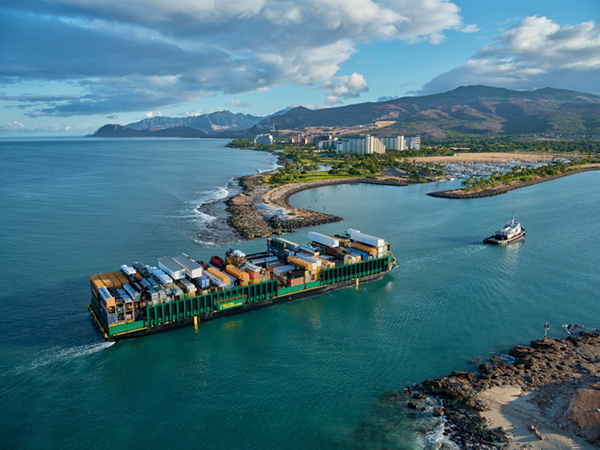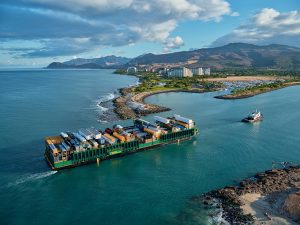
As those in the know are already aware, there’s potential for growth in the Alaska and Hawaii regions. For years, West Coast companies have been cultivating a presence in the two states, expanding services, investing in new ships and lending their expertise to projects that are expected to bolster the states’ economies.
Whether it’s new vessels or infrastructure projects, interesting things are happening in Alaska and Hawaii. Here’s a look at what’s been happening with respect to the maritime industry within the Aloha State and the Last Frontier.
Pasha
The Pasha Group’s presence in Hawaii is significant, as the company known for its bulk and break bulk transport services has been investing heavily in the state for years. As part of its continued infrastructure and vessel investment plan for the region’s maritime services, Pasha Hawaii is building a pair of new Ohana Class container vessels. (‘Ohana’ is a Hawai’ian term meaning ‘family.’)
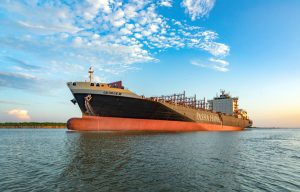
The first vessel, the m/v George III, is expected to enter service later this year, followed soon by the second vessel, the m/v Janet Marie.
When m/v George III makes its inaugural sail from the Port of Long Beach, it will be considered the first natural gas-powered containership to call on the West Coast and the first to service Hawaii, according to Pasha spokeswoman Emily Sinclair.
From Day One, both vessels will run completely on natural gas and will surpass the International Maritime Organization 2030 standards for ocean vessels with close to zero sulfur emissions, including a 99.9% reduction in particulate matter; a 90% reduction in nitrogen oxide; and 25% less carbon dioxide as compared to liquid fuel oils, according to Pasha.
In addition to its investment in vessels, Pasha Hawaii sister company Hawaii Stevedores, is working with the state of Hawaii and the Harbors Division of the Hawaii Department of Transportation on the long-awaited new Kapalama Container Terminal, or KCT.
In March, Hawaii officials lauded the completion of the first phase of the $500 million project—the biggest capital improvement project in the state’s history—and kicked off the project’s second phase, which is centered on wharf development.
Improvements during the first phase featured a 65.9-acre container yard, support buildings, internally contained entry and exit gates, security fencing, parking, five electric gantry cranes and container handling equipment, on-site utilities, remotely controlled outdoor energy-efficient LED lighting, a truck weigh station, and other ancillary features to make it more efficient and convenient for customers.
Also incorporated is on-dock container-to-barge operations, a move that’s expected to remove more than 50,000 truck moves off of local streets and highways for nearby island transfers, according to officials.
The project’s second phase – awarded in late 2020 for $352.5 million – includes an additional 18.5 acres of container yard, with 1,863 linear feet of additional berthing capacity, according to Pasha. The work will encompass a number of improvements, including deeper dredging of the waterfront and harbor channel, broadening Pier 41 for inter-island barge/vessels, reconstructing Pier 41 for roll-on/roll-off operations and structural upgrades to Pier 40 to support roll-on/roll-off cargo operations.
When completed and operational by 2024, the terminal “will significantly improve cargo handling productivity and capabilities, serving as the future home for Hawaii Stevedores,” Pasha said. “Through the use of technology and world-class design, KCT will serve as one of the state’s most efficient operating terminals.”
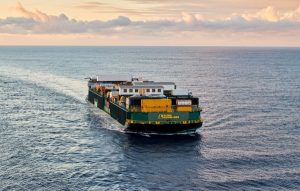
Lynden
Freight shipping and logistics provider Lynden, which has offices in Anchorage and Seattle, has family of companies extends all over the world providing transportation and logistics solutions, including Canada and the U.S. West Coast, particularly arin Alaska and Hawaii.
Lynden subsidiaries Alaska Marine Lines and Aloha Marine Lines offer barge services to Alaska and Hawaii, respectively. The company provides bi-weekly barge service between the Pacific Northwest and Honolulu, and coordinates inter-island services to the neighboring islands of Kauai, Maui, Hawaii, Molokai and Lanai. Lynden companies also provide air and ocean forwarding between Hawaii and anywhere in the U.S. or other countries.
They also offer services between Seattle and Alaska, including weekly sailings to Southeast and Central Alaska, and seasonal sailings to Western and Arctic Alaska.
“In total, we sail to nearly 100 towns and villages in Alaska,” Alaska Marine Lines and Aloha Marine Lines Director of Sales Bret Harper said. “Lynden companies serve the entire state of Alaska and offer a full range of transportation options across all modes – air, land and sea.”
To keep up with demand, Aloha Marine Lines raised its cargo capacity to Hawaii by 35% in the past year with the purchase of two high-capacity barges, the Kamakani and Namakani. The barges each span 438 feet in length, 105 feet in width, and have a deadweight capacity of 16,869 tons. Both are fitted with 22-foot-high cargo binwalls, which help to keep freight secure while curbing the amount of lashing needed for each voyage, Harper said.
“We just recently repainted the Namakani, and it’s great to see our traditional green and yellow colors sailing past Honolulu,” he said. “On the barges you will often notice building materials such as lumber and plywood products, roofing materials, pipe, wallboard, rebar and structural steel, in addition to machinery, office trailers, tower cranes and over-dimensional cargo needed to support projects.”
Meanwhile, Aloha Marine Lines recently moved from Pier 29 in Honolulu to Barber’s Point in Kapolei, Hawaii. The new location brings the company close to the area’s industrial park.
“We have many customers in that area, and the new location makes deliveries much more efficient,” Harper explained.
Lynden also recently added 600 new refrigerated shipping containers to its fleet of nearly 29,000 shipping containers, flats and tanks.
“Many will be used for transporting seafood products from Alaska, but they can carry all types of temperature controlled products,” Harper said. “We know equipment has been tied up in many supply chains around the globe, and we’ve put an emphasis on ensuring we can provide the right equipment needed at the right time for our customers.”
Lynden continues to innovate its processes and equipment. For example, the company offers 102-inch-wide, 53-foot-long containers and platforms. The added width and height make shipping more efficient and have been popular on the company’s Seattle to Hawaii route, Harper said.
“We also feature Kaptive Beam decking systems that allow freight to be stacked higher in the container without crushing the bottom pallets, so space can safely and efficiently be maximized,” he added.
Lynden companies were also busy with COVID-19 pandemic-related services, coordinating with partners to buy and move 78 pallets of personal protective equipment—and even chartered a FedEx plane from China to Anchorage—when a shortage of such items threatened the health and safety of Alaska’s frontline workers.
“Employees were waiting in Anchorage and quickly unloaded the material and palletized it for next-morning delivery to the Alaska Department of Health and Social Services,” according to Lynden.
Lynden also organized delivery of COVID-19 vaccine doses from Anchorage to remote parts of Western Alaska, along with personal protective equipment for those giving the shots.
And when flights were limited from Hawaii to the mainland and animal shelters in Hawaii were crowded with homeless pets unable to go to their adoptive homes, a Lynden Hercules cargo plane went to Hawaii to pick up the animals on behalf of a customer and brought them to Seattle so they could be adopted. The flight carried more than 600 cats and dogs to new homes.
“Lynden provides a supply lifeline to many communities across Alaska, and is an important transportation provider to Hawaii, and we’re proud that our services have continued uninterrupted,” Harper said. “Throughout the pandemic Lynden has maintained regular business operations and the critical supply chains to Alaska, Hawaii, and other remote locations were kept intact. Our focus remains on keeping delivery routes open and supplies moving.”
American Marine Corp.
American Marine Corp. has been working on various projects throughout the West Coast, including Hawaii and Alaska. In Alaska, AMC has been experiencing a very strong seasonal workload this year, including aging marine infrastructure and new installations, and has completed multiple technically challenging projects while maintaining a zero TRIR (Total Recordable Incident Rate) record.
“Our Alaska-based team is comprised of employees with some of the best local technical knowledge in the industry,” American Marine Corp. Executive Vice President David Shahnazarian said. “This is a critical component of our decades of success working in some of the harshest marine environments both above and below the waterline.”
The company is also experiencing one of its busiest times in the Hawaii region in recent years, Shahnazarian said.
“Construction projects this year range from maintenance dredging to port improvements with project locations spread throughout the Hawaiian Islands,” he explained. “Our marine transportation business line has been hard at work this year with an increase in vessel movements from last year.”
In Hawaii, American Marine is a sub-contractor to Kiewit Infrastructure West Co. to replenish more than 20,000 cubic yards of sand to Waikiki Beach.
For Cape Environmental Management Inc., AMC has so far applied about 3.9 million pounds of activated carbon under piers and open water areas in Pearl Harbor to keep contaminates at bay. The project highlighted the company’s creativity and innovation. To meet the required application thickness, AMC placed a blower machine on a barge to distribute activated carbon under the pier. When applying in open water, AMC came up with the idea to create a floating target box with HDPE piping, and added turbidity curtains to make a mobile containment area while AC was applied.
AMC was also hired by the U.S. Army Corps of Engineers to perform maintenance dredging at Port Allen in Kauai, work that involved crews digging about 482,000 cubic yards in two 12-hour shifts over 90 days.
As a sub-contractor to International Construction, Inc., AMC is part of a Naval Facilities Engineering Command project in Pearl Harbor, Oahu. The project calls for a new boat ramp and finger pier, which will help meet the growing needs of the U.S. Navy Seal teams based at Joint Base Pearl Harbor Hickam.
To pre-drill and install new concrete piles that will support the new ramp and finger pier, AMC is relying on a Watson EDT-7 hydraulic drill rig, its derrick barge AMC 160, and Delmag D36 diesel hammer to get the job done. After pile driving, the derrick barge AMC 160 along with AMC’s ADCI certified divers will put in underwater precast concrete pile caps, suspended slab, and boat ramp panels, according to the company.
“Our Hawaii team has been working on the Hawaiian and Outer Pacific Islands since the early ‘70s and therefore they are able to bring a high level of local expertise that our clients have come to rely on,” Shahnazarian said. “In addition, our organization is investing back into our marine construction and vessel fleet to best position ourselves for the multitude of future opportunities we foresee in the upcoming years.”
Pacific Pile & Marine
Earlier this year, the Seattle-based Pacific Pile & Marine announced a couple of projects that it’s involved in Alaska, including the second phase of the Port of Alaska project in Anchorage. PPM’s work involves installing piles using a DB Pacific Lifter. A spreader bar was created and designed specifically to handle the piles.
“The piles have been coated with an epoxy coating system to prevent corrosion following installation,” the company explained in a press release.
The company is also involved in a National Science Foundation project to reconstruct the pier at its research facility on Anvers Island, Antarctica. When completed by July 2022, the 80-foot-wide, 118-foot-long pier is expected to be three times bigger than before, and extend into deeper water so larger ships can be moored, according to the company.
Harbor Expansion in Hawaii?
Even as work continues on the Kapalama Container Terminal project, Hawaii transportation officials are considering a potential expansion of Honolulu Harbor.
The concept is being included in the Honolulu Harbor 2050 Master Plan. Officials are currently seeking feedback on the plan, which is proposing a deeper and wider harbor, adding a second entrance and developing a lock and dam system to protect against sea level rise.
Derek Chow, deputy director of the state transportation department’s Harbors Division, spoke to Hawaii Public Radio program The Conversation in July about the importance of Honolulu Harbor, where a majority of cargo coming into the state comes into Honolulu Harbor.
“We do want to protect our primary harbor,” Chow told The Conversation. “We do want to upgrade it so that it meets future demands. And we certainly want to be able to recover from a storm or prevent experiencing damages when a storm passes.”
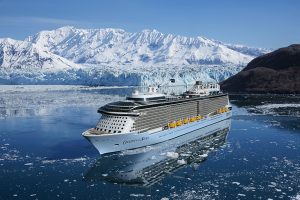
Cruising in Alaska
Cruising seems to be returning to Alaska in a major way, after a pandemic-driven downturn. In July, Alaska welcomed its first cruise ship with the arrival of Royal Caribbean’s Serenade of the Seas, whose seven-day voyage included stops in Juneau, Sitka, Ketchikan and Icy Strait Point.
It was a major moment for a state that saw a significant economic generator disappear due to COVID-19. Cruise tourism accounts for over 60% of Alaska visitors and as much as $3 billion annually.
Royal Caribbean’s Ovation of the Seas, whose seven-night voyage features stops in Skagway, Sitka and Juneau and through the Inside Passage, will enjoy an extended Alaska season with four more sailings through October.
This past summer, Ketchikan, Alaska, saw ships return to the area with the opening of a new cruise dock. Built on a former pulp mill that shuttered in 1997, the new multi-million-dollar dock will be able to welcome two neopanamax-sized ships at the same time. In August, the Norwegian Encore was one of the first vessels to call.
Ward Cove Dock Group President John Binkley teamed with fellow Ketchikan businessmen Dave and Andrew Spokely and Norwegian Cruise Lines on the project. Binkley expressed his delight about arriving cruise ships after the COVID-19 pandemic derailed the 2020 season.
“We’re excited the ships are coming back to Alaska,” Binkley told Pacific Maritime Magazine’s Alaska Bureau Chief, Margaret Bauman. “I feel great, excited, over the moon. The island is
all excited.”

